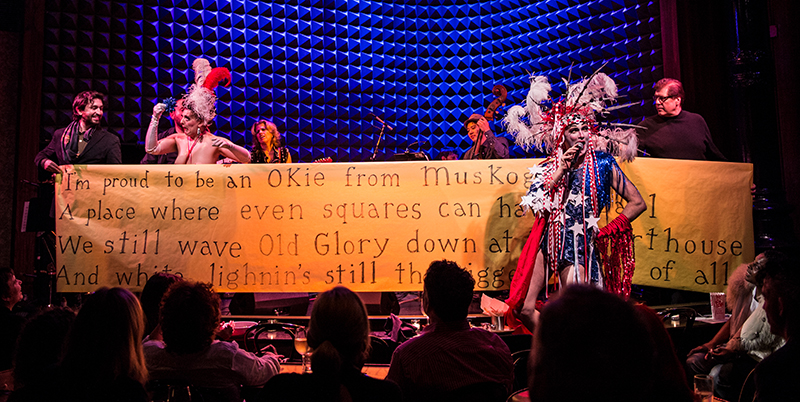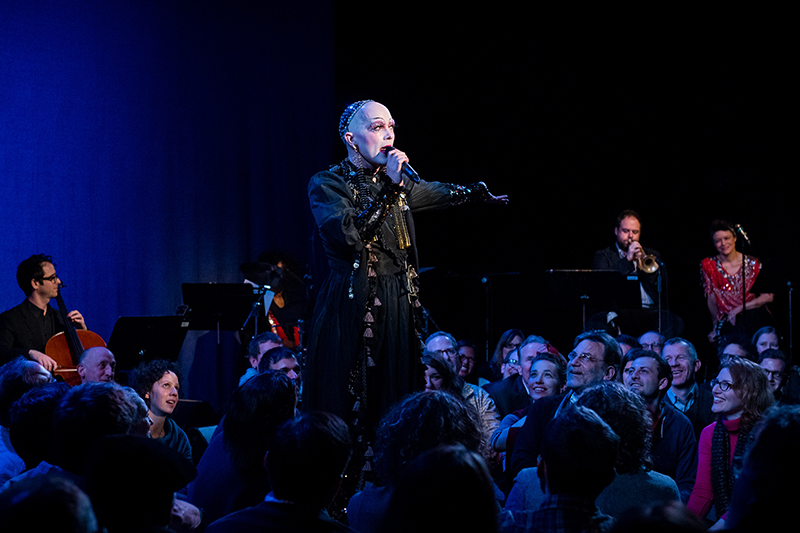Taylor Mac: Manifesting Our Future Through Performance
Art
Mac’s performances are not created alone—and judy recognizes this. Judy works extremely collaboratively and encourages heightened artistic creativity. For instance, judy’s costume designer, Machine Dazzle, is simply given the summary of the performance or story, and Dazzle will create a great work of art for Mac. “He’s the artist,” says Mac. “Let him make it, and I will be the vessel for the art onstage. It’s not how most collaborators work—it’s not how most things happen nowadays. But I’m determined to continue to work with my collaborators to say, ‘This is what it’s about. Now make something.’” Mac’s collaborations are invested in trust.”You commit to their art,” judy says. And judy’s right— this isn’t the typical format of a theater. Theater tends to be very specific with one ideal goal in mind, and everyone adjusts their art accordingly. Mac, however, believes this type of work is harmful to the creative. “Designers have been kind of oppressed into becoming simple technicians instead of artists,” judy says. “I feel, as the lead artist on a project, it’s my job to bring Machine’s art and my lighting designer’s art and scenic designer’s art, and I’m the one that has to stitch them together. They don’t need to change for me.”

Mac’s encouraging and inclusive technique doesn’t end at judy’s collaborators and audience, however. In fact, it begins with Mac. “I use theater as a way to understand,” judy says. “The act of performing, creating the work and … inviting people to the work to share it with them—that in itself is a balm for anything that I can’t quite figure out or [that] I’m struggling with in my life.” Also problematic is the desire to understand at all. “The world is extremely large,” Mac says. “There’s this quality specifically in our country—but most other countries as well—where there’s a movement for people to reduce themselves into something that is understandable because we are as large as the world. So what they want you to do, either to sell you or to understand you, is for you to get rid of your complexity.” Mac hopes that judy’s performances are where complexity can thrive and we can explore it, rather than reducing ourselves to a single thing. “When you look at me,” Mac says, “you’re not just seeing a man or a woman. You’re not just seeing somebody who has it all pulled together and understands things, but you’re also not seeing somebody who is completely chaotic and doesn’t get it. You’re seeing something that’s ugly and beautiful, graceful and clumsy—you’re seeing the full range of who I am, including the things I don’t usually show on the outside.”
Taylor Mac’s hope for our future, and the future of theater still weighs on me in a lovely way. Mac wants to see brave writers again; playwrights who aren’t afraid to directly say what they’re thinking or what the subject matter of the play is. Even more, Mac hopes for a day in theater when we stop continually focusing on the horrible and focus more on manifesting what we want the world to be. “We can’t not comment on what is,” Mac says. “We can’t ignore what’s going on. But I really hope we figure out a way to let the lead aspect of the story be manifesting the world as we want it, as opposed to dissecting the world that is.” The 24-Decade project exists in a space between recognizing the horrid and portraying what Mac and judy’s community want the world to look like. “Doing both allows us to then dream a culture forward as opposed to getting stuck in the quagmire,” says Mac.
You don’t want to miss this beautiful and wild spirit onstage on Jan. 14 at 7:30 p.m. at Kingsbury Hall. For more information or to purchase tickets, visit utahpresents.org/events/taylor-mac.
